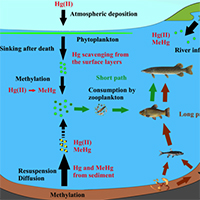Mercury methylation in oxic aquatic macro-environments: a review

Accepted: 27 February 2021
HTML: 106
All claims expressed in this article are solely those of the authors and do not necessarily represent those of their affiliated organizations, or those of the publisher, the editors and the reviewers. Any product that may be evaluated in this article or claim that may be made by its manufacturer is not guaranteed or endorsed by the publisher.
Authors
Mercury methylation in aquatic environments is a key process that incorporates this neurotoxin into the food chain and ultimately the human diet. Mercury methylation is considered to be essentially biotic and mainly driven by sulfate-reducing bacteria present in the bottom sediments in aquatic systems. However, in recent decades, many researchers have shown that this methylation also occurs in oxic layers in conjunction with a high content of particulate organic matter and localized depletion of dissolved oxygen. The goals of this review are to summarize our current understanding of Hg methylation in water columns of both marine and freshwater environments, as well as to highlight knowledge gaps and future research needs. Most of the literature showed that suspended particles (known as marine and lake snow) could be the microenvironment in which Hg methylation could occur across oxic water columns, because they have been recognized as a site of organic matter mineralization and as presenting oxygen gradients around and inside them. To date, the majority of these studies concern marine environments, highlighting the need for more studies in freshwater environments, particularly lacustrine systems. Investigating this new methylmercury production environment is essential for a better understanding of methylmercury incorporation into the trophic chain. In this review, we also propose a model which attempts to highlight the relative importance of a MeHg epilimnetic path over a MeHg benthic-hypolimnetic path, especially in deep lakes. We believe that this model could help to better focus future scientific efforts in limnic environments regarding the MeHg cycle.
Edited by
Diego Fontaneto, CNR-IRSA, Verbania, ItalyHow to Cite

This work is licensed under a Creative Commons Attribution-NonCommercial 4.0 International License.
Similar Articles
- D. Christopher Rogers, Hatching response to temperature along a latitudinal gradient by the fairy shrimp Branchinecta lindahli (Crustacea; Branchiopoda; Anostraca) in culture conditions , Journal of Limnology: Vol. 74 No. 1 (2015)
- Fernando G. Spaccesi, Alberto Rodrigues Capitulo, Benthic communities on hard substrates covered by Limnoperna fortunei Dunker (Bivalvia, Mytilidae) at an estuarine beach (Río de la Plata, Argentina) , Journal of Limnology: Vol. 71 No. 1 (2012)
- Lene Jacobsen, Søren Berg, Henrik Baktoft, P. Anders Nilsson, Christian Skov, The effect of turbidity and prey fish density on consumption rates of piscivorous Eurasian perch Perca fluviatilis , Journal of Limnology: Vol. 73 No. 1 (2014)
- Diane M. Orihel, Rebecca C. Rooney, A field-based technique for sediment incubation experiments , Journal of Limnology: Vol. 71 No. 1 (2012)
- Tadeusz Penczak, Despite anthropogenic disturbance and moderate climate changes fish density and biomass fluctuated non directionally in a small stream , Journal of Limnology: Vol. 74 No. 2 (2015)
- Amanda Valois, Keith Somers, Chantal Sarrazin-Delay, Wendel (Bill) Keller, Are bioassessments based on the reference condition approach affected by rapid approaches to sample collection and processing? , Journal of Limnology: Vol. 75 No. 2 (2016)
- Elisa A.C.C. Alvim, Adriana O. Medeiros, Renan S. Rezende, José F. Gonçalves Júnior, Leaf breakdown in a natural open tropical stream , Journal of Limnology: Vol. 74 No. 2 (2015)
- Anna C.F. Aguiar, Vinicius Neres-Lima, Timothy P. Moulton, Relationships of shredders, leaf processing and organic matter along a canopy cover gradient in tropical streams , Journal of Limnology: Vol. 77 No. 1 (2018)
- Bruna Suelen da Silva, Eugenia Zandona, Vinicius Neres de Lima, Timothy P. Moulton, Flavia Tromboni, Steven A. Thomas, Rafael Feijó-Lima, Longitudinal effects of land-cover transitions on the periphyton community of a tropical stream , Journal of Limnology: Vol. 83 (2024)
- Stefano Fenoglio, Tiziano Bo, Massimo Cammarata, Manuel J. López-Rodríguez, José M. Tierno de Figueroa, Seasonal variation of allochthonous and autochthonous energy inputs in an alpine stream , Journal of Limnology: Vol. 74 No. 2 (2015)
<< < 36 37 38 39 40 41 42 43 44 45 > >>
You may also start an advanced similarity search for this article.
-
Juanjo RodríguezFrontiers in Marine Science : 2023
-
Thibaut Cossart, Javier Garcia-Calleja, João P. Santos, Elaheh Lotfi Kalahroodi, Isabelle A. M. Worms, Zoyne Pedrero, David Amouroux, Vera I. Slaveykova, Kevin WilkinsonEnvironmental Chemistry : 2022
-
Eric Capo, Claudia Cosio, Elena Gascón Díez, Jean-Luc Loizeau, Elsa Mendes, Thierry Adatte, Sören Franzenburg, Andrea G. BravoWater Research : 2023
-
Laura Marziali, Roberta Piscia, Lucia Valsecchi, Claudio Roscioli, Marina MancaWater : 2022
-
Laura Balzer, Carluvy Baptista-Salazar, Sofi Jonsson, Harald BiesterBiogeosciences : 2023
-
Diva Scuvée, Marisol Goñi-Urriza, Claire Gassie, Bahia Khalfaoui-Hassani, Rémy GuyoneaudMicrobiological Research : 2023
-
María del Carmen Diéguez, Marina Arcagni, Andrea Rizzo, Soledad Pérez Catán, Carolina Soto Cárdenas, Milena Horvat, Sergio Ribeiro GuevaraNatural and Social Sciences of Patagonia : 2022
-
Vincent Noël, Kristin Boye, Hannah R. Naughton, Emily M. Lacroix, Meret Aeppli, Naresh Kumar, Scott Fendorf, Samuel M. WebbFrontiers in Environmental Chemistry : 2024
-
Daniel González-Reguero, Marina Robas-Mora, Agustín Probanza Lobo, Pedro Antonio Jiménez GómezWorld Journal of Microbiology and Biotechnology : 2023

 https://doi.org/10.4081/jlimnol.2021.2007
https://doi.org/10.4081/jlimnol.2021.2007





